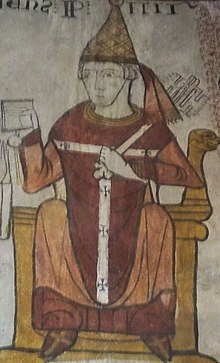
Back Pous Clemens IV Afrikaans Climent IV AN كليمنت الرابع Arabic كليمنت الرابع ARZ Клімент IV Byelorussian Климент IV Bulgarian Klemañs IV Breton Papa Klement IV BS Climent IV Catalan Gáu-huòng Clemens 4-sié CDO
Clement IV | |
|---|---|
| Bishop of Rome | |
 Clement IV depicted in a 13th century fresco | |
| Church | Catholic Church |
| Papacy began | 5 February 1265 |
| Papacy ended | 23 November 1268 |
| Predecessor | Urban IV |
| Successor | Gregory X |
| Previous post(s) |
|
| Orders | |
| Consecration | 1257 |
| Created cardinal | 17 December 1261 by Urban IV |
| Personal details | |
| Born | Gui Foucois c. 23 November 1190 |
| Died | 29 November 1268 (aged 78) Viterbo, Papal States |
| Coat of arms |  |
| Other popes named Clement | |
Ordination history of Pope Clement IV | |||||||||||||||||||||||||||
|---|---|---|---|---|---|---|---|---|---|---|---|---|---|---|---|---|---|---|---|---|---|---|---|---|---|---|---|
| |||||||||||||||||||||||||||
| |||||||||||||||||||||||||||
Pope Clement IV (Latin: Clemens IV; c. 23 November 1190 – 29 November 1268), born Gui Foucois (Latin: Guido Falcodius; French: Guy de Foulques or Guy Foulques)[1] and also known as Guy le Gros (French for "Guy the Fat"; Italian: Guido il Grosso), was bishop of Le Puy (1257–1260), archbishop of Narbonne (1259–1261), cardinal of Sabina (1261–1265), and head of the Catholic Church from 5 February 1265 until his death. His election as pope occurred at a conclave held at Perugia that lasted four months while cardinals argued over whether to call in Charles I of Anjou, the youngest brother of Louis IX of France, to carry on the papal war against the Hohenstaufens. Pope Clement was a patron of Thomas Aquinas and of Roger Bacon, encouraging Bacon in the writing of his Opus Majus, which included important treatises on optics and the scientific method.